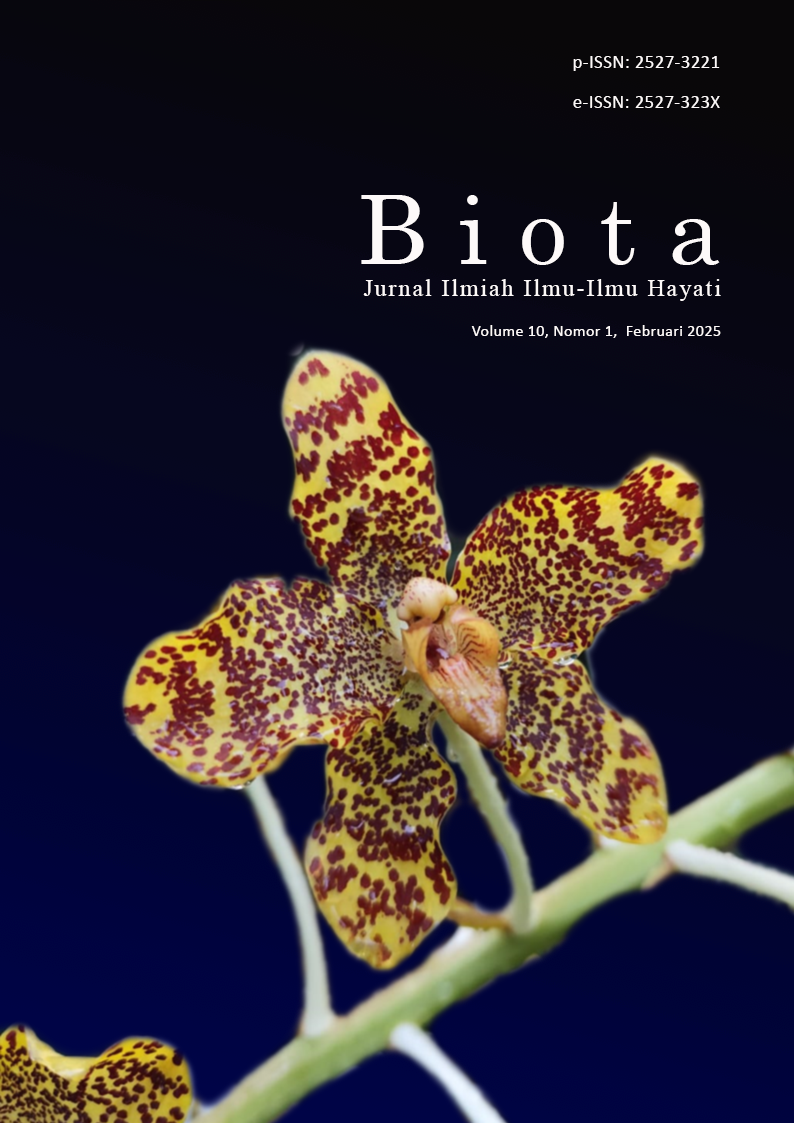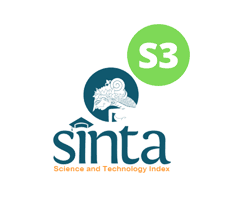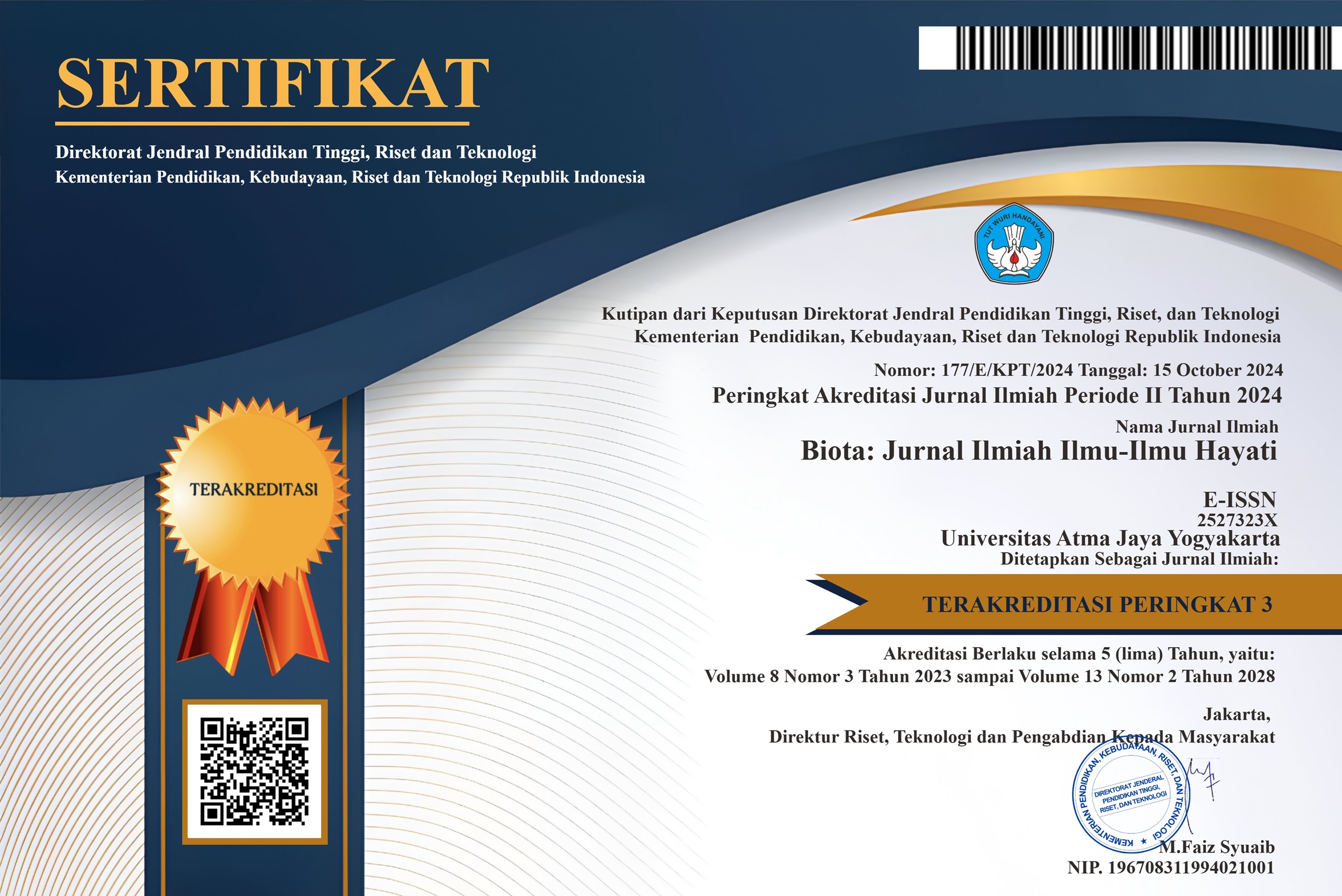Isolation and Electrochemical Evaluation of Electrogenic Bacteria from the Sediment of Two Waterlogged-Ecosystems
DOI:
https://doi.org/10.24002/biota.v10i1.9476Keywords:
Bioelectricity, electron acceptor, electron donor, microbial fuel cell, thioglycollate mediaAbstract
Electrogenic microbes have been exploited in the microbial fuel cell (MFC) system for harvesting bioelectricity. Electrogens are widely distributed in various environments, but the exploration of this microbial group from ecosystems in Indonesia is still limited. This present study aimed to isolate the electrogenic bacteria from sediments of two waterlogged ecosystems (dam and paddy field) using serial dilution into extinction method prior to streak plate method on the solid thioglycollate media supplemented with Fe3+. Electrochemical evaluation was conducted in glucose-fed dual-chamber MFC by using Arduino UNO-based data logger for the accurate monitoring of electricity production in the term of open circuit voltage (OCV). A total of 54 electrogens were successfully isolated from these two ecosystems, ranging from weakness to strongest electrogens (OCV >800 mV) and ranging from microaerophilic, aerotolerant and facultative anaerobes, to obligate anaerobes. This result also suggested that sediment of waterlogged ecosystems rich in electron donor and solid acceptor electron compounds could potentially host electrogenic microbes. The exploration of electrogens from many other waterlogged ecosystems in Indonesia, both natural and anthropic ecosystems, could be conducted to collect genetic resources of novel electrogenic bacteria for the development of MFC technology in Indonesia.
References
An, J., & Lee, H-S. (2014). Occurrence and implications of voltage reversal in stacked microbial fuel cells. ChemSusChem 7(6):1689-1695.
Brewer, J.H. (1940). Clear liquid mediums for the aerobic cultivation of anaerobes. JAMA 115(8):598-600.
Brioukhanov, A.L., Thauer, R.K., & Netrusov, A.I. (2002). Catalase and superoxide dismutase in the cells of strictly anaerobic microorganisms. Microbiology 71(3):281-285.
Carlson, H.K., Iavarone, A.T., Gorur, A., Yeo, B.S., Tran, R., Melnyk, R.A., Mathies, R.A., Auer, M., & Coates, J.D. (2012). Surface multiheme c-type cytochromes from Thermincola potens and implications for respiratory metal reduction by Gram-positive bacteria. Proceedings of the National Academy of Science of the United States of America 109(5):1702-1707.
Chabert, N., Amin, A.O., & Achouak, W. (2015). All ecosystems potentially host electrogenic bacteria. Bioelectrochemistry 106:88-96.
Chandrasekhar, K., & Mohan, S.V. (2012). Bio-electrochemical remediation of real field petroleum sludge as an electron donor with simultaneous power generation facilitates biotransformation of PAH: Effect of substrate concentration. Bioresource Technology 110:517-525.
Chang, I.S., Moon, H., Jang, J.K., & Kim, B.H. (2005). Improvement of a microbial fuel cell performance as a BOD sensor using respiratory inhibitors. Biosensors and Bioelectronics 20(9):1856-1859.
Colombo, C., Palumbo, G., He, J-Z., Pinton, R., & Cesco, S. (2013). Review on iron availability in soil: interaction of Fe minerals, plants, and microbes. Journal of Soils and Sediments 14:538-548.
Erensoy, A., Mulayim, S., Orhan, A., Çek, N., Tuna, A., & Ak, N. (2022). The system design of the peat-based microbial fuel cell as a new renewable energy source: The potential and limitations. Alexandria Engineering Journal 61(11):8743-8750.
Hasanah, A.S. (2020). Isolation and Characterization of Fe and Mn-reducing Microbes for Microbial Fuel Cell. [Master Thesis]. IPB University. Bogor.
Indriyani, Y.A. (2017). Exploration, Selection, and Identification of Electricigens Bacteria Isolated from Ecosystems in Indonesia for Microbial Fuel Cell (MFC). [Master Thesis]. IPB University. Bogor.
Indriyani, Y.A. (2023). "Research Mapping on MFC Studies in Indonesia", In: Exploration and Efficiency Evaluation of Electrogenic Microbes Isolated from Sediment of Three Ecosystems in Indonesia for MFC (Microbial Fuel Cell). [Dissertation]. IPB University. Bogor.
Indriyani, Y.A., Efendi, R., Rustami, E., Rusmana, I., Anwar, S., Djajakirana, G., & Santosa, D.A. (2024a). Affordable ESP32-based monitoring system for microbial fuel cells: real-time analysis and performance evaluation (ESP32-based data logger as a monitoring system for microbial fuel cell). International Journal Energy and Water Resources 8:199-212.
Indriyani, Y.A., Rusmana, I., Anwar, S., Djajakirana, G., & Santosa, D.A. (2024c). Bioelectrochemical assessment of a novel electrogenic Bacillus altitudinis AC11.2 for electricity generation in microbial fuel cell (MFC) system. Journal of Applied Electrochemistry 54:977-997.
Indriyani, Y.A., Rusmana, I., Anwar, S., Djajakirana, G., & Santosa, D.A. (2023c). Harvesting bioelectricity from Microbial Fuel Cells (MFCs) powered by electroactive microbes. Journal Lampung Agricultural Engineering 12(3):583-596.
Indriyani, Y.A., Rustami, E., Rusmana, I., Anwar, S., Djajakirana, G., & Santosa, D.A. (2024b). Bioelectricity production of microbial fuel cells (MFCs) and the simultaneous monitoring using developed multi-channels Arduino UNO-based data logging system. Journal of Applied Electrochemistry 54:503-518.
Liu, H., Cheng, S., & Logan, B.E. (2005). Production of electricity from acetate or butyrate using a single-chamber microbial fuel cell. Environmental Science and Technology 39(2):658-662.
Logan, B.E., Hamelers, B., Rozendal, R., Schröder, U., Keller, J., Freguia, S., Aelterman, P., Verstraete, W., & Rabaey, K. (2006). Microbial fuel cells: Methodology and technology. Environmental Science and Technology 40(17):5181-5192.
Lovley, D.R. (2006). Bug juice: harvesting electricity with microorganisms. Nature Reviews Microbiology 4(7):497-508.
Lovley, D.R., & Holmes, D.E. (2022). Electromicrobiology: the ecophysiology of phylogenetically diverse electroactive microorganisms. Nature Review Microbiology 20(1):5-19.
Lovley, D.R., Holmes, D.E., & Nevin, K.P. (2004). Dissimilatory Fe(III) and Mn(IV) reduction. Advances in Microbial Physiology 49:219-286.
Merck. (2021). Fluid Thioglycollate Medium Data Sheet. Preparation, Separation, Filtration, and Monitoring Products. https://www.sigmaaldrich.com/deepweb/assets/sigmaaldrich/product/ documents/457/894/146220dat-mk. Accessed on May 2022.
Modestra, J.A., & Mohan, S.V. (2014). Bio-electrocatalyzed electron efflux in Gram positive and Gram negative bacteria: an insight into disparity in electron transfer kinetics. RSC Advances 4(64):34045-34055.
Mohan, S.V., Sravan, J.S., Butti, S.K., Krishna, K.V., Modestra, J.A., Velvizhi, G., Kumar, A.N., Varjani, S., & Pandey, A. (2019). Chapter 1.1. Microbial Electrochemical Technology: Emerging and Sustainable Platform. In: Mohan SV et al. Ed. MET. Elvevier. pp. 3-18.
NCCLS. (2004). Performance standards for antimicrobial susceptibility testing, 14th informational supplement. NCCLS document M100-S14. National Committee for Clinical Laboratory Standards, Wayne
Rabaey, K., & Verstraete, W. (2005). Microbial fuel cells: Novel biotechnology for energy generation. Trends in Biotechnology 23(6):291-298.
Riyanto, B., Mubarik, N.R., & Idham, F. (2011). Electrical energy from Jakarta Bay marine sediment through microbial fuel cell technology. Jurnal Pengolahan Hasil Perikanan Indonesia. 16(1):32-42.
Sreelekshmy, B.R. (2020). Exploration of electrochemically active bacterial strains for microbial fuel cells: An innovation in bioelectricity generation. Journal of Pure and Applied Microbiology 14(1):103-122.
Sydow, A., Krieg, T., Mayer, F., Schrader, J., & Holtmann, D. (2014). Electroactive bacteria-molecular mechanisms and genetic tools. Applied Microbiology and Biotechnology 98(20):8481-8495.
Wang, N., Chen, Z., Li, H-B., Su, J-Q., Zhao, F., & Zhu, Y-G. (2015). Bacterial community composition at anodes of microbial fuel cells for paddy soils: The effects of soil properties. Journal of Soils and Sediments 15(4):926-936.
White, G.F., Edwards, M.J., Gomez-Perez, L., Richardson, D.J., Butt, J.N., & Clarke, T.A. (2016). Mechanisms of Bacterial Extracellular Electron Exchange. Chapter 3. In: Poole RK, Ed. Advances in Microbial Physiology. Academic Press. pp
Wiryawan, B.N.A.P, Mahendra, I.N.A., Kuntayoni, N.A., & Dewanti, A.I.A. (2014). “Analisis Potensi Sedimen Hutan Bakau sebagai Sumber Energi Listrik dengan Menggunakan Teknologi Sedimen Microbial Fuel Cell (SMFC)”. Prosiding Seminar Nasional FMIPA UNDIKSHA IV. pp. 399-407.
Yee, M.O., Snoeyenbos-West, O.L., Thamdrup, B., Ottosen, L.D.M., & Rotaru, A.E. (2019). Extracellular electron uptake by two Methanosarcina species. Frontiers in Energy Research 7(29):1-10.
Downloads
Published
How to Cite
Issue
Section
License
Copyright (c) 2025 Yohanna Anisa Indriyani, Iman Rusmana, Syaiful Anwar, Gunawan Djajakirana, Dwi Andreas Santosa

This work is licensed under a Creative Commons Attribution-NonCommercial 4.0 International License.
Authors who publish with Biota : Jurnal Ilmiah Ilmu-Ilmu Hayati agree to the following terms:
- Authors retain copyright and grant the Biota : Jurnal Ilmiah Ilmu-Ilmu Hayati right of first publication. Licensed under a Creative Commons Attribution-NonCommercial 4.0 International License that allows others to share the work with an acknowledgment of the work's authorship and initial publication in this journal.
- Authors are able to enter into separate, additional contractual arrangements for the non-exclusive distribution of the journal's published version of the work (e.g., post it to an institutional repository or publish it in a book), with an acknowledgment of its initial publication in Biota : Jurnal Ilmiah Ilmu-Ilmu Hayati, and as long as Author is not used for commercial purposes.













